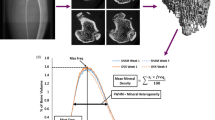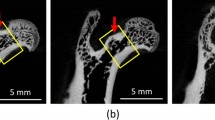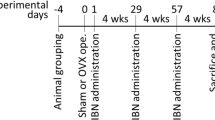Abstract
This study investigated the protective effect of long-term treatment with the bisphosphonate zoledronic acid on bone mass, structure, and strength in adult, estrogen-deficient rats. Rats were ovariectomized (OVX) at the age of 4 months and divided into four groups of 20 rats: one group of saline-treated OVX controls, and three groups of OVX rats treated with 0.3, 1.5, or 7.5 μg/kg/week s.c. zoledronic acid (ZOL). An additional group of sham-operated, saline-treated rats served as normal controls. Biochemical assays were performed after 16 and 51 weeks, respectively, and bone mineral density (BMD) determinations after 17 and 52 weeks, respectively. Before the end of the experiment animals were injected with tetracyclines for the determination of dynamic bone indexes. Finally, animals were sacrificed after 52 weeks, and vertebral bones (LV5) were subjected to mechanical compression testing. LV4 were used for histology and LV2 for microcomputed tomography. ZOL treatment abolished the rise of osteocalcin and reduced urinary deoxypyridinoline excretion. BMD was reduced in the OVX group in comparison to sham controls, and the decline was dose-dependently prevented by ZOL treatment. Tetracycline labeling showed a significant increase in bone formation rate (BFR) in OVX rats which was abolished by ZOL treatment. The same was observed for osteoid perimeter (Os.Pm) suggesting that ZOL diminished the high bone turnover associated with estrogen deficiency. Architectural parameters (BV/TV, Tb.Th*, Tb.N*, Tb.Sp*, SMI, CD) underwent the expected changes toward structural deterioration which was completely prevented by ZOL administration at doses of 1.5 and 7.5 μg/kg/week s.c. Similar results were obtained in compression testing: maximum stress fell significantly after OVX, and this effect was effectively prevented by ZOL treatment. Regression analysis suggests that in this rat model, SMI and Tb.Th* significantly contribute to compressive strength, albeit to a smaller degree than total cross-sectional area. The data further suggest that in the aged OVX rat, SMI and TB.Th* change in an interdependent way. ZOL prevents this process by inhibiting plate thinning and the transition into rod-shaped trabeculae.






Similar content being viewed by others
References
Russell RGG, Rogers MJ (1999) Bisphosphonates: from the laboratory to the clinic and back again. Bone 25:97–106
Green JR, Müller K, Jaeggi KA (1994) Preclinical pharmacology of CGP42’446, a potent, heterocyclic bisphosphonate compound. J Bone Miner Res 9:745–751
Wellington K, Goa KL (2003) Zoledronic acid: a review of its use in the management of bone metastases and hypercalcaemia of malignancy. Drugs 63:417–437
Wronsky TJ, Dann LM, Horner (1989) Time course of vertebral osteopenia in ovariectomized rats. Bone 10:295–301
Rüegsegger P, Koller B, Müller R (1996) A microtomographic system for the nondestructive evaluation of bone architecture. Calcif Tissue Int 58:24–29
Glatt M. The bisphosphonate zoledronate prevents vertebral bone loss in mature estrogen-deficient rats as assessed by micro-computed tomography. Eur Cells Materials 2001;1:18–26. http://www.ecmjournal.org Cited 3 February 2004
Hildebrand T, Rüegsegger P (1997) A new method for the model independent assessment of thickness in three-dimensional images. J Microsc 185:67–75
Hildebrand T, Rüegsegger P (1997) Quantification of bone microarchitecture with the structure model index. Comp Meth Biomech Biomed Eng 1:15–23
Odgaard A, Gundersen HJG (1993) Quantification of connectivity in cancellous bone, with special emphasis on 3-D reconstructions. Bone 14:173–182
Pataki A, Müller K, Green JR, Ma YF, Li QN, Jee WSS (1997) Effects of short-term treatment with the bisphophonates zoledronate and pamidronate on rat bone: a comparative histomorphometric study on the cancellous bone formed before, during and after treatment. Anat Rec 249:458–468
Frost MA, Drezner MK, Glorieux FH, Kanis JA, Malluche H, Meunier PJ, Ott SM, Recker RR (1987) Bone histomorphometry: standardization of nomenclature, symbols, and units. J Bone Miner Res 6:595–610
Kollerup G, Thamsborg G, Bhatia H, Sorensen OH (1992) Quantitation of urinary hydroxypyridinium cross-links from collagen by high-performance liquid chromatography. Scand J Clin Lab Invest 52:657–662
Yoshimura Y, Ohnishi K, Hamamura M, Oda T, Sohda T (1993) Automated high-performance liquid chromatographic determination of hydroxylysyl-pyridinoline and lysylpyridinoline in urine using a column-switching method. J Chromatogr 613:43–49
Mosekilde L, Danielsen CC, Knudsen UB (1993) The effect of aging and ovariectomy on the vertebral bone mass and biomechanical properties of mature rats. Bone 14:1–6
15 Mashiba T, Hirano T, Turner CH et al (2000) Suppressed bone turnover by bisphosphonates increases microdamage accumulation and reduces some biomechanical properties in dog rib. J Bone Miner Res 15:621–625
16 Kinney JH, Haupt DL, Balooch M, Ladd AJC, Ryaby JT, Lane NE (2000) Three-dimensional morphometry of the L6 vertebra in the ovariectomized rat model of osteoporosis: biomechanical implications. J Bone Miner Res 15:1981–1991
Parfitt AM, Mathews CH, Villanueva AR, Kleerekoper M, Frame B, Rao DS (1983) Relationship between surface, volume, and thickness of iliac trabecular bone in aging and in osteoporosis: implications for the microanatomic and cellular mechanisms of bone loss. J Clin Invest 72:1396–1409
Mitton D, Cendre E, Roux J-P et al (1998) Mechanical properties of ewe vertebral cancellous bone compared with histomorphometry and high-resolution computed tomography parameters. Bone 22:651–658
Toolan BC, Shea M, Myers ER, Borchers ER, Seedor JG, Quartuccio H, Rodan G, Hayes WC (1992) Effects of 4-amino-1-hydroxybutylidene bisphosphonate on bone biomechanics in rats. J Bone Miner Res 7:1399–1406
Guy JA, Shea M, Peter CP, Morrissey R, Hayes WC (1993) Continuous alendronate treatment throughout growth, maturation, and aging in the rat results in increases in bone mass and mechanical properties. Clacif Tissue Int 53:283–288
Lalla S, Hothorn LA, Haag N, Bader R, Bauss F (1998) Lifelong administration of high doses of ibandronate increases bone mass and maintains bone quality of lumber vertebrae in rats. Osteoporos Int 8:97–103
Thomsen JS, Ebbesen EN, Mosekilde LI (2002) Predicting human vertebral bone strength by vertebral static histomorphometry. Bone 30:502–508
Hildebrand T, Laib A, Müller R et al (1999) Direct three-dimensional morphometric analysis of human cancellous bone: microstructural data from spine, femur, iliac crest, and calcaneus. J Bone Miner Res 14:1167–1174
Ferretti JL, Mondelo N, Capozza RF, Cointry GR, Zanchetta JR, Montuori E (1995) Effects of large doses of olpadronate (dimethyl-pamidronate) on mineral density, cross-sectional architecture, and mechanical properties of rat femurs. Bone 4S:285S–293S
Hornby SB, Evans GP, Hornby SL, Pataki A, Glatt M, Green JR (2003) Long-term zoledronic acid treatment increases bone structure and mechanical strength of long bones of ovariectomized adult rats. Calcif Tissue Int 72:519–527
Author information
Authors and Affiliations
Corresponding author
Rights and permissions
About this article
Cite this article
Glatt, M., Pataki, A., Evans, G.P. et al. Loss of vertebral bone and mechanical strength in estrogen-deficient rats is prevented by long-term administration of zoledronic acid. Osteoporos Int 15, 707–715 (2004). https://doi.org/10.1007/s00198-004-1588-3
Received:
Accepted:
Published:
Issue Date:
DOI: https://doi.org/10.1007/s00198-004-1588-3




